Reflective Report on Business Environment and Organizations
VerifiedAdded on 2020/10/22
|11
|3097
|295
Report
AI Summary
This report provides a reflective analysis of the business environment, focusing on private, public, and voluntary organizations. It examines the characteristics, missions, visions, legal forms, and stakeholders of ALDI (private), NHS (public), and Wellcome Trust (voluntary). The report utilizes Porter's Five Forces model to compare the competitive positions of these organizations, analyzing factors such as bargaining power of buyers and suppliers, the threat of new entrants and substitutes, and the intensity of competitive rivalry. Additionally, the report incorporates Gibb's Reflective Cycle to reflect on personal experiences and insights related to the business environment and organizational analysis. The report aims to provide a comprehensive understanding of the interplay between organizations and their operating environments.
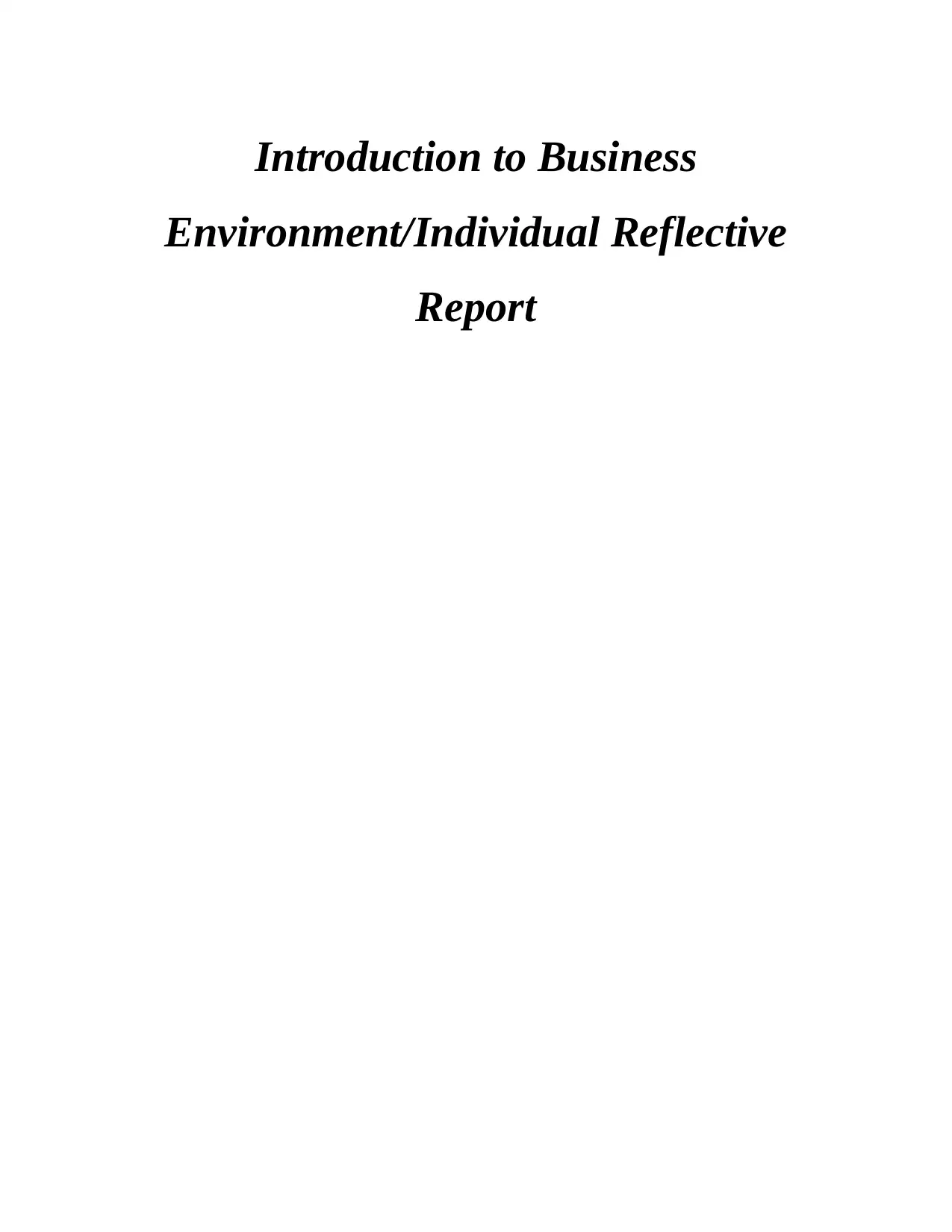
Introduction to Business
Environment/Individual Reflective
Report
Environment/Individual Reflective
Report
Paraphrase This Document
Need a fresh take? Get an instant paraphrase of this document with our AI Paraphraser
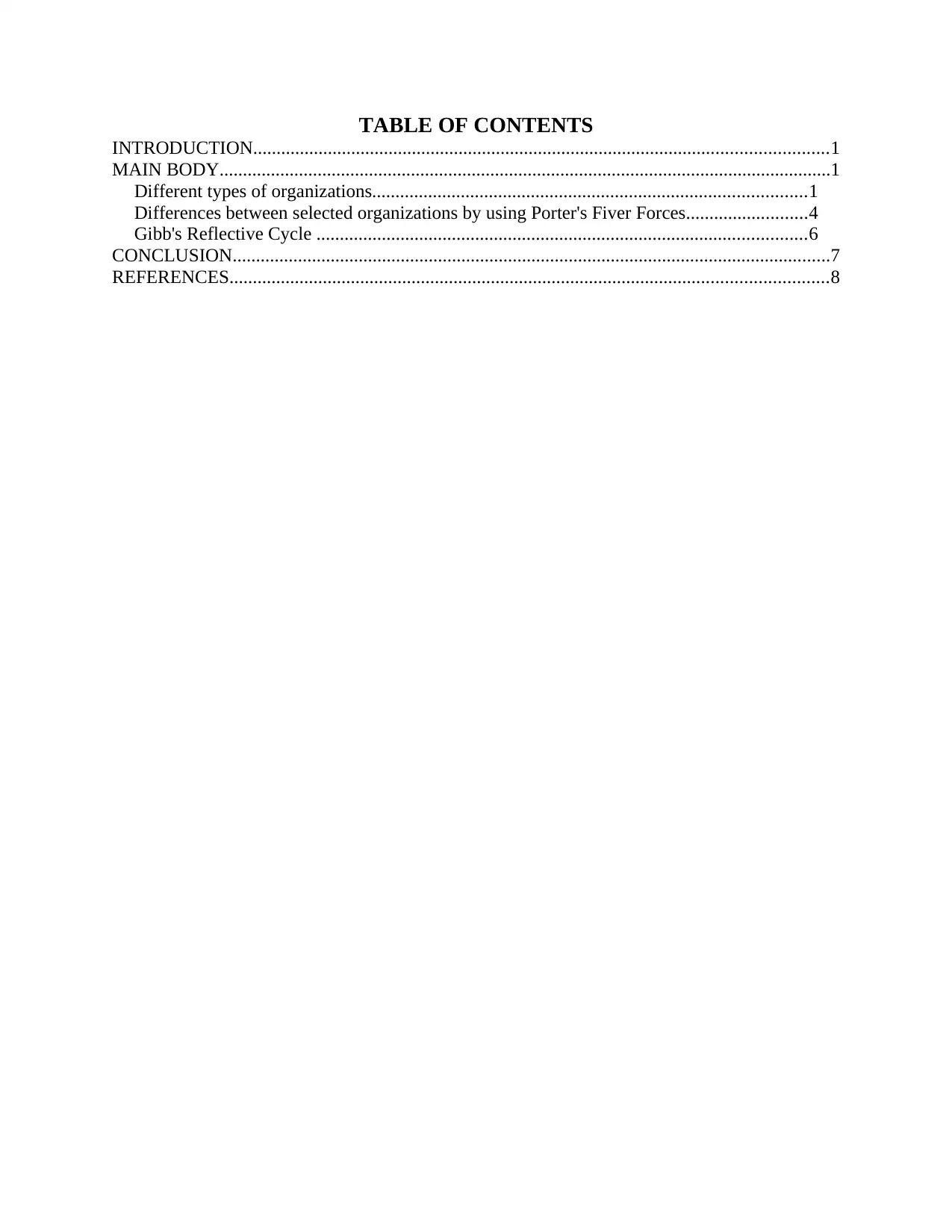
TABLE OF CONTENTS
INTRODUCTION...........................................................................................................................1
MAIN BODY...................................................................................................................................1
Different types of organizations.............................................................................................1
Differences between selected organizations by using Porter's Fiver Forces..........................4
Gibb's Reflective Cycle .........................................................................................................6
CONCLUSION................................................................................................................................7
REFERENCES................................................................................................................................8
INTRODUCTION...........................................................................................................................1
MAIN BODY...................................................................................................................................1
Different types of organizations.............................................................................................1
Differences between selected organizations by using Porter's Fiver Forces..........................4
Gibb's Reflective Cycle .........................................................................................................6
CONCLUSION................................................................................................................................7
REFERENCES................................................................................................................................8
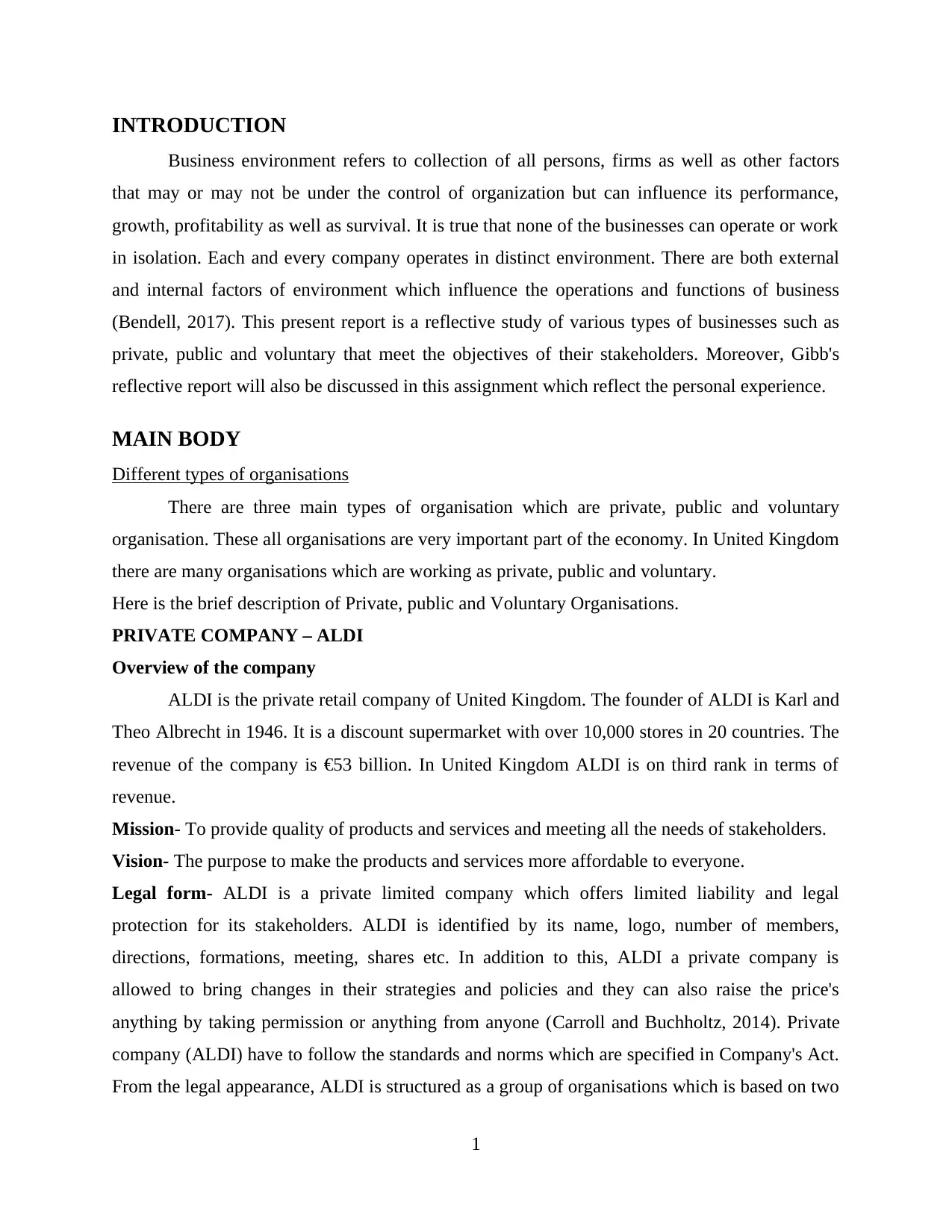
INTRODUCTION
Business environment refers to collection of all persons, firms as well as other factors
that may or may not be under the control of organization but can influence its performance,
growth, profitability as well as survival. It is true that none of the businesses can operate or work
in isolation. Each and every company operates in distinct environment. There are both external
and internal factors of environment which influence the operations and functions of business
(Bendell, 2017). This present report is a reflective study of various types of businesses such as
private, public and voluntary that meet the objectives of their stakeholders. Moreover, Gibb's
reflective report will also be discussed in this assignment which reflect the personal experience.
MAIN BODY
Different types of organisations
There are three main types of organisation which are private, public and voluntary
organisation. These all organisations are very important part of the economy. In United Kingdom
there are many organisations which are working as private, public and voluntary.
Here is the brief description of Private, public and Voluntary Organisations.
PRIVATE COMPANY – ALDI
Overview of the company
ALDI is the private retail company of United Kingdom. The founder of ALDI is Karl and
Theo Albrecht in 1946. It is a discount supermarket with over 10,000 stores in 20 countries. The
revenue of the company is €53 billion. In United Kingdom ALDI is on third rank in terms of
revenue.
Mission- To provide quality of products and services and meeting all the needs of stakeholders.
Vision- The purpose to make the products and services more affordable to everyone.
Legal form- ALDI is a private limited company which offers limited liability and legal
protection for its stakeholders. ALDI is identified by its name, logo, number of members,
directions, formations, meeting, shares etc. In addition to this, ALDI a private company is
allowed to bring changes in their strategies and policies and they can also raise the price's
anything by taking permission or anything from anyone (Carroll and Buchholtz, 2014). Private
company (ALDI) have to follow the standards and norms which are specified in Company's Act.
From the legal appearance, ALDI is structured as a group of organisations which is based on two
1
Business environment refers to collection of all persons, firms as well as other factors
that may or may not be under the control of organization but can influence its performance,
growth, profitability as well as survival. It is true that none of the businesses can operate or work
in isolation. Each and every company operates in distinct environment. There are both external
and internal factors of environment which influence the operations and functions of business
(Bendell, 2017). This present report is a reflective study of various types of businesses such as
private, public and voluntary that meet the objectives of their stakeholders. Moreover, Gibb's
reflective report will also be discussed in this assignment which reflect the personal experience.
MAIN BODY
Different types of organisations
There are three main types of organisation which are private, public and voluntary
organisation. These all organisations are very important part of the economy. In United Kingdom
there are many organisations which are working as private, public and voluntary.
Here is the brief description of Private, public and Voluntary Organisations.
PRIVATE COMPANY – ALDI
Overview of the company
ALDI is the private retail company of United Kingdom. The founder of ALDI is Karl and
Theo Albrecht in 1946. It is a discount supermarket with over 10,000 stores in 20 countries. The
revenue of the company is €53 billion. In United Kingdom ALDI is on third rank in terms of
revenue.
Mission- To provide quality of products and services and meeting all the needs of stakeholders.
Vision- The purpose to make the products and services more affordable to everyone.
Legal form- ALDI is a private limited company which offers limited liability and legal
protection for its stakeholders. ALDI is identified by its name, logo, number of members,
directions, formations, meeting, shares etc. In addition to this, ALDI a private company is
allowed to bring changes in their strategies and policies and they can also raise the price's
anything by taking permission or anything from anyone (Carroll and Buchholtz, 2014). Private
company (ALDI) have to follow the standards and norms which are specified in Company's Act.
From the legal appearance, ALDI is structured as a group of organisations which is based on two
1
⊘ This is a preview!⊘
Do you want full access?
Subscribe today to unlock all pages.

Trusted by 1+ million students worldwide
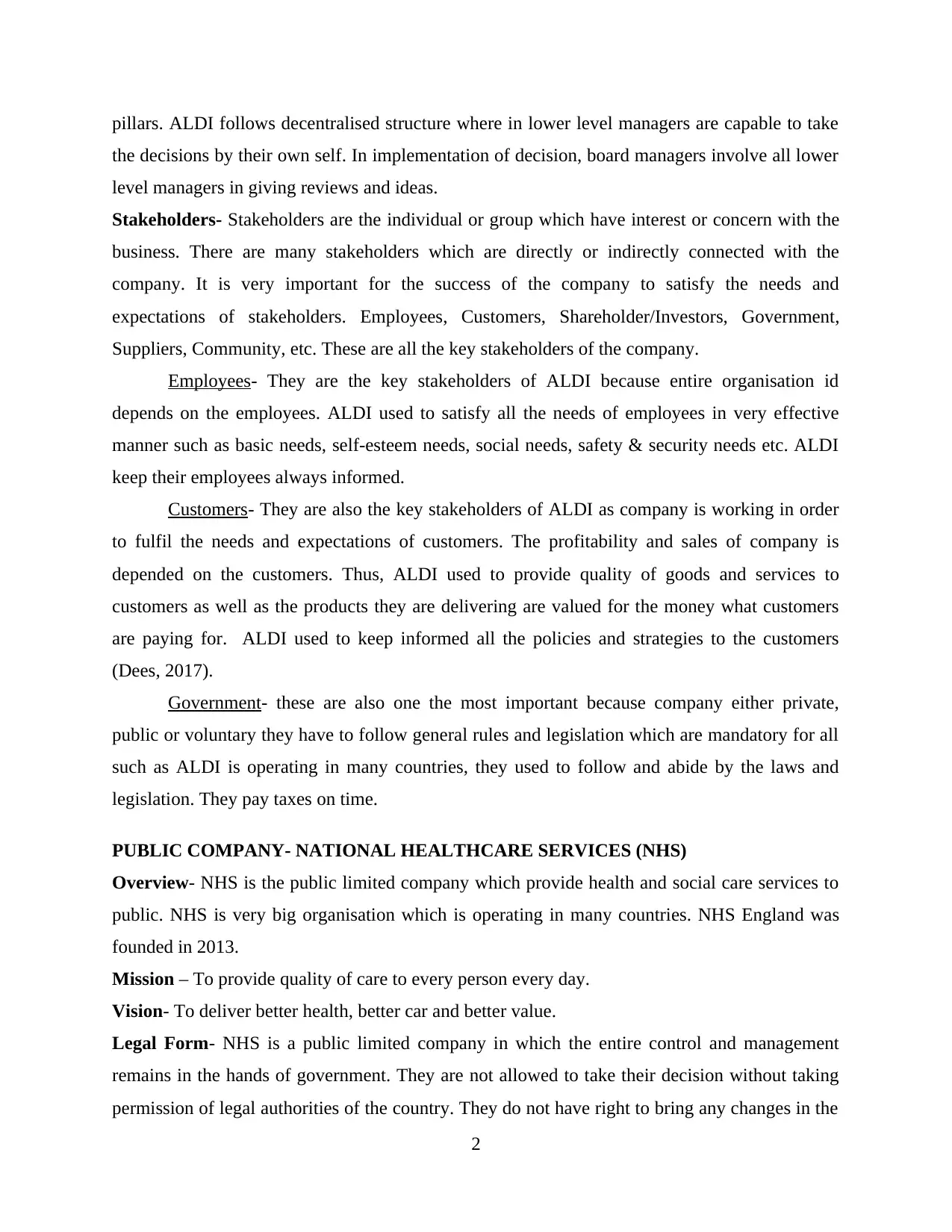
pillars. ALDI follows decentralised structure where in lower level managers are capable to take
the decisions by their own self. In implementation of decision, board managers involve all lower
level managers in giving reviews and ideas.
Stakeholders- Stakeholders are the individual or group which have interest or concern with the
business. There are many stakeholders which are directly or indirectly connected with the
company. It is very important for the success of the company to satisfy the needs and
expectations of stakeholders. Employees, Customers, Shareholder/Investors, Government,
Suppliers, Community, etc. These are all the key stakeholders of the company.
Employees- They are the key stakeholders of ALDI because entire organisation id
depends on the employees. ALDI used to satisfy all the needs of employees in very effective
manner such as basic needs, self-esteem needs, social needs, safety & security needs etc. ALDI
keep their employees always informed.
Customers- They are also the key stakeholders of ALDI as company is working in order
to fulfil the needs and expectations of customers. The profitability and sales of company is
depended on the customers. Thus, ALDI used to provide quality of goods and services to
customers as well as the products they are delivering are valued for the money what customers
are paying for. ALDI used to keep informed all the policies and strategies to the customers
(Dees, 2017).
Government- these are also one the most important because company either private,
public or voluntary they have to follow general rules and legislation which are mandatory for all
such as ALDI is operating in many countries, they used to follow and abide by the laws and
legislation. They pay taxes on time.
PUBLIC COMPANY- NATIONAL HEALTHCARE SERVICES (NHS)
Overview- NHS is the public limited company which provide health and social care services to
public. NHS is very big organisation which is operating in many countries. NHS England was
founded in 2013.
Mission – To provide quality of care to every person every day.
Vision- To deliver better health, better car and better value.
Legal Form- NHS is a public limited company in which the entire control and management
remains in the hands of government. They are not allowed to take their decision without taking
permission of legal authorities of the country. They do not have right to bring any changes in the
2
the decisions by their own self. In implementation of decision, board managers involve all lower
level managers in giving reviews and ideas.
Stakeholders- Stakeholders are the individual or group which have interest or concern with the
business. There are many stakeholders which are directly or indirectly connected with the
company. It is very important for the success of the company to satisfy the needs and
expectations of stakeholders. Employees, Customers, Shareholder/Investors, Government,
Suppliers, Community, etc. These are all the key stakeholders of the company.
Employees- They are the key stakeholders of ALDI because entire organisation id
depends on the employees. ALDI used to satisfy all the needs of employees in very effective
manner such as basic needs, self-esteem needs, social needs, safety & security needs etc. ALDI
keep their employees always informed.
Customers- They are also the key stakeholders of ALDI as company is working in order
to fulfil the needs and expectations of customers. The profitability and sales of company is
depended on the customers. Thus, ALDI used to provide quality of goods and services to
customers as well as the products they are delivering are valued for the money what customers
are paying for. ALDI used to keep informed all the policies and strategies to the customers
(Dees, 2017).
Government- these are also one the most important because company either private,
public or voluntary they have to follow general rules and legislation which are mandatory for all
such as ALDI is operating in many countries, they used to follow and abide by the laws and
legislation. They pay taxes on time.
PUBLIC COMPANY- NATIONAL HEALTHCARE SERVICES (NHS)
Overview- NHS is the public limited company which provide health and social care services to
public. NHS is very big organisation which is operating in many countries. NHS England was
founded in 2013.
Mission – To provide quality of care to every person every day.
Vision- To deliver better health, better car and better value.
Legal Form- NHS is a public limited company in which the entire control and management
remains in the hands of government. They are not allowed to take their decision without taking
permission of legal authorities of the country. They do not have right to bring any changes in the
2
Paraphrase This Document
Need a fresh take? Get an instant paraphrase of this document with our AI Paraphraser
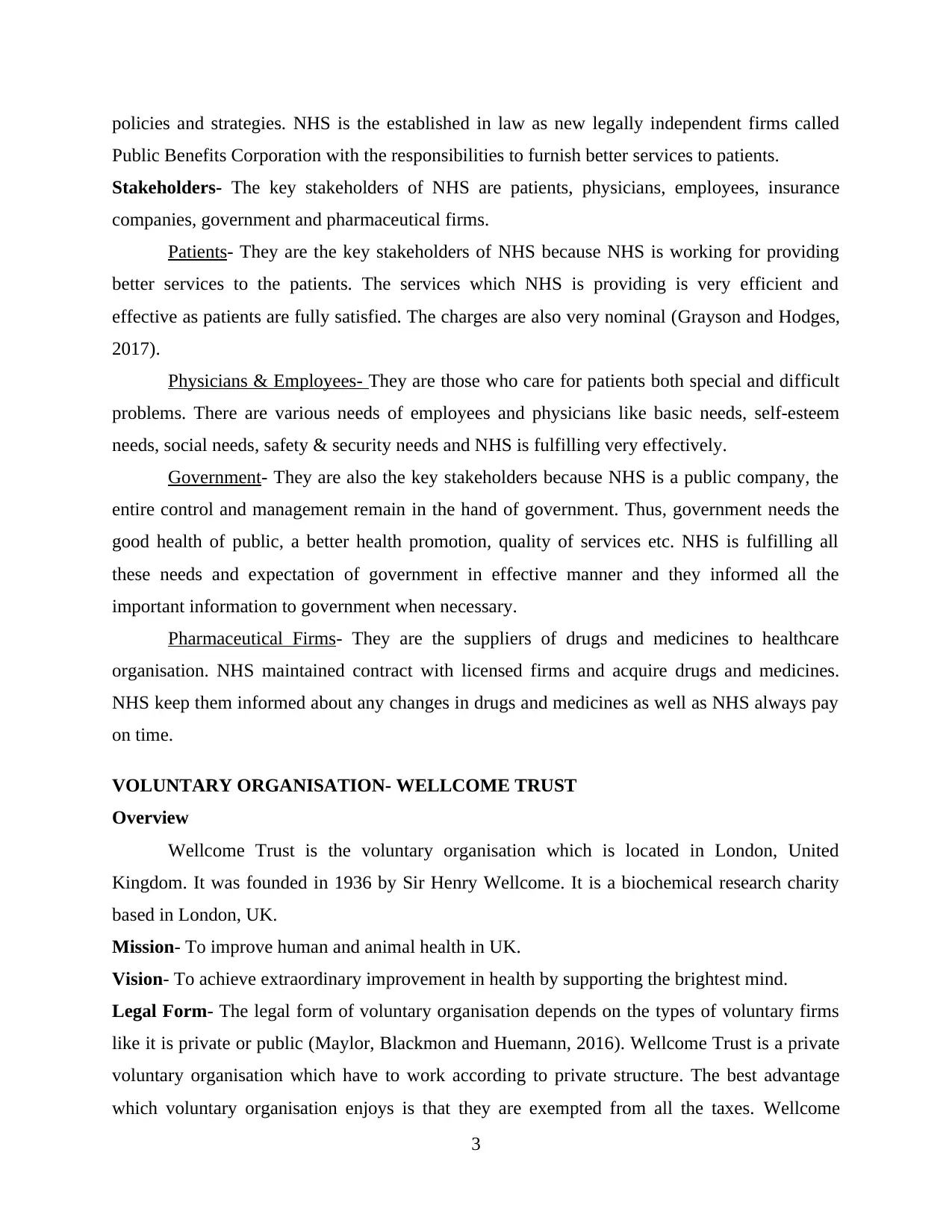
policies and strategies. NHS is the established in law as new legally independent firms called
Public Benefits Corporation with the responsibilities to furnish better services to patients.
Stakeholders- The key stakeholders of NHS are patients, physicians, employees, insurance
companies, government and pharmaceutical firms.
Patients- They are the key stakeholders of NHS because NHS is working for providing
better services to the patients. The services which NHS is providing is very efficient and
effective as patients are fully satisfied. The charges are also very nominal (Grayson and Hodges,
2017).
Physicians & Employees- They are those who care for patients both special and difficult
problems. There are various needs of employees and physicians like basic needs, self-esteem
needs, social needs, safety & security needs and NHS is fulfilling very effectively.
Government- They are also the key stakeholders because NHS is a public company, the
entire control and management remain in the hand of government. Thus, government needs the
good health of public, a better health promotion, quality of services etc. NHS is fulfilling all
these needs and expectation of government in effective manner and they informed all the
important information to government when necessary.
Pharmaceutical Firms- They are the suppliers of drugs and medicines to healthcare
organisation. NHS maintained contract with licensed firms and acquire drugs and medicines.
NHS keep them informed about any changes in drugs and medicines as well as NHS always pay
on time.
VOLUNTARY ORGANISATION- WELLCOME TRUST
Overview
Wellcome Trust is the voluntary organisation which is located in London, United
Kingdom. It was founded in 1936 by Sir Henry Wellcome. It is a biochemical research charity
based in London, UK.
Mission- To improve human and animal health in UK.
Vision- To achieve extraordinary improvement in health by supporting the brightest mind.
Legal Form- The legal form of voluntary organisation depends on the types of voluntary firms
like it is private or public (Maylor, Blackmon and Huemann, 2016). Wellcome Trust is a private
voluntary organisation which have to work according to private structure. The best advantage
which voluntary organisation enjoys is that they are exempted from all the taxes. Wellcome
3
Public Benefits Corporation with the responsibilities to furnish better services to patients.
Stakeholders- The key stakeholders of NHS are patients, physicians, employees, insurance
companies, government and pharmaceutical firms.
Patients- They are the key stakeholders of NHS because NHS is working for providing
better services to the patients. The services which NHS is providing is very efficient and
effective as patients are fully satisfied. The charges are also very nominal (Grayson and Hodges,
2017).
Physicians & Employees- They are those who care for patients both special and difficult
problems. There are various needs of employees and physicians like basic needs, self-esteem
needs, social needs, safety & security needs and NHS is fulfilling very effectively.
Government- They are also the key stakeholders because NHS is a public company, the
entire control and management remain in the hand of government. Thus, government needs the
good health of public, a better health promotion, quality of services etc. NHS is fulfilling all
these needs and expectation of government in effective manner and they informed all the
important information to government when necessary.
Pharmaceutical Firms- They are the suppliers of drugs and medicines to healthcare
organisation. NHS maintained contract with licensed firms and acquire drugs and medicines.
NHS keep them informed about any changes in drugs and medicines as well as NHS always pay
on time.
VOLUNTARY ORGANISATION- WELLCOME TRUST
Overview
Wellcome Trust is the voluntary organisation which is located in London, United
Kingdom. It was founded in 1936 by Sir Henry Wellcome. It is a biochemical research charity
based in London, UK.
Mission- To improve human and animal health in UK.
Vision- To achieve extraordinary improvement in health by supporting the brightest mind.
Legal Form- The legal form of voluntary organisation depends on the types of voluntary firms
like it is private or public (Maylor, Blackmon and Huemann, 2016). Wellcome Trust is a private
voluntary organisation which have to work according to private structure. The best advantage
which voluntary organisation enjoys is that they are exempted from all the taxes. Wellcome
3
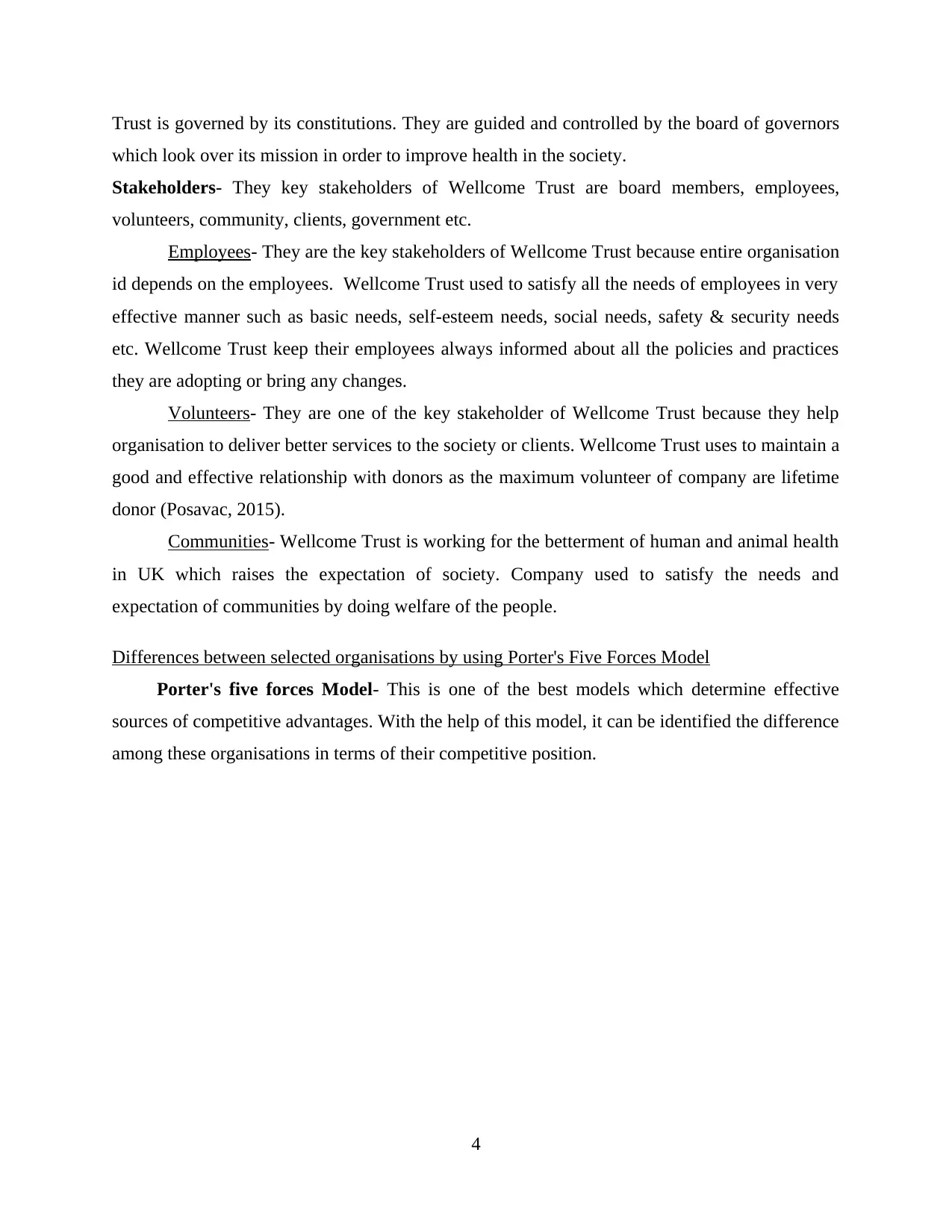
Trust is governed by its constitutions. They are guided and controlled by the board of governors
which look over its mission in order to improve health in the society.
Stakeholders- They key stakeholders of Wellcome Trust are board members, employees,
volunteers, community, clients, government etc.
Employees- They are the key stakeholders of Wellcome Trust because entire organisation
id depends on the employees. Wellcome Trust used to satisfy all the needs of employees in very
effective manner such as basic needs, self-esteem needs, social needs, safety & security needs
etc. Wellcome Trust keep their employees always informed about all the policies and practices
they are adopting or bring any changes.
Volunteers- They are one of the key stakeholder of Wellcome Trust because they help
organisation to deliver better services to the society or clients. Wellcome Trust uses to maintain a
good and effective relationship with donors as the maximum volunteer of company are lifetime
donor (Posavac, 2015).
Communities- Wellcome Trust is working for the betterment of human and animal health
in UK which raises the expectation of society. Company used to satisfy the needs and
expectation of communities by doing welfare of the people.
Differences between selected organisations by using Porter's Five Forces Model
Porter's five forces Model- This is one of the best models which determine effective
sources of competitive advantages. With the help of this model, it can be identified the difference
among these organisations in terms of their competitive position.
4
which look over its mission in order to improve health in the society.
Stakeholders- They key stakeholders of Wellcome Trust are board members, employees,
volunteers, community, clients, government etc.
Employees- They are the key stakeholders of Wellcome Trust because entire organisation
id depends on the employees. Wellcome Trust used to satisfy all the needs of employees in very
effective manner such as basic needs, self-esteem needs, social needs, safety & security needs
etc. Wellcome Trust keep their employees always informed about all the policies and practices
they are adopting or bring any changes.
Volunteers- They are one of the key stakeholder of Wellcome Trust because they help
organisation to deliver better services to the society or clients. Wellcome Trust uses to maintain a
good and effective relationship with donors as the maximum volunteer of company are lifetime
donor (Posavac, 2015).
Communities- Wellcome Trust is working for the betterment of human and animal health
in UK which raises the expectation of society. Company used to satisfy the needs and
expectation of communities by doing welfare of the people.
Differences between selected organisations by using Porter's Five Forces Model
Porter's five forces Model- This is one of the best models which determine effective
sources of competitive advantages. With the help of this model, it can be identified the difference
among these organisations in terms of their competitive position.
4
⊘ This is a preview!⊘
Do you want full access?
Subscribe today to unlock all pages.

Trusted by 1+ million students worldwide
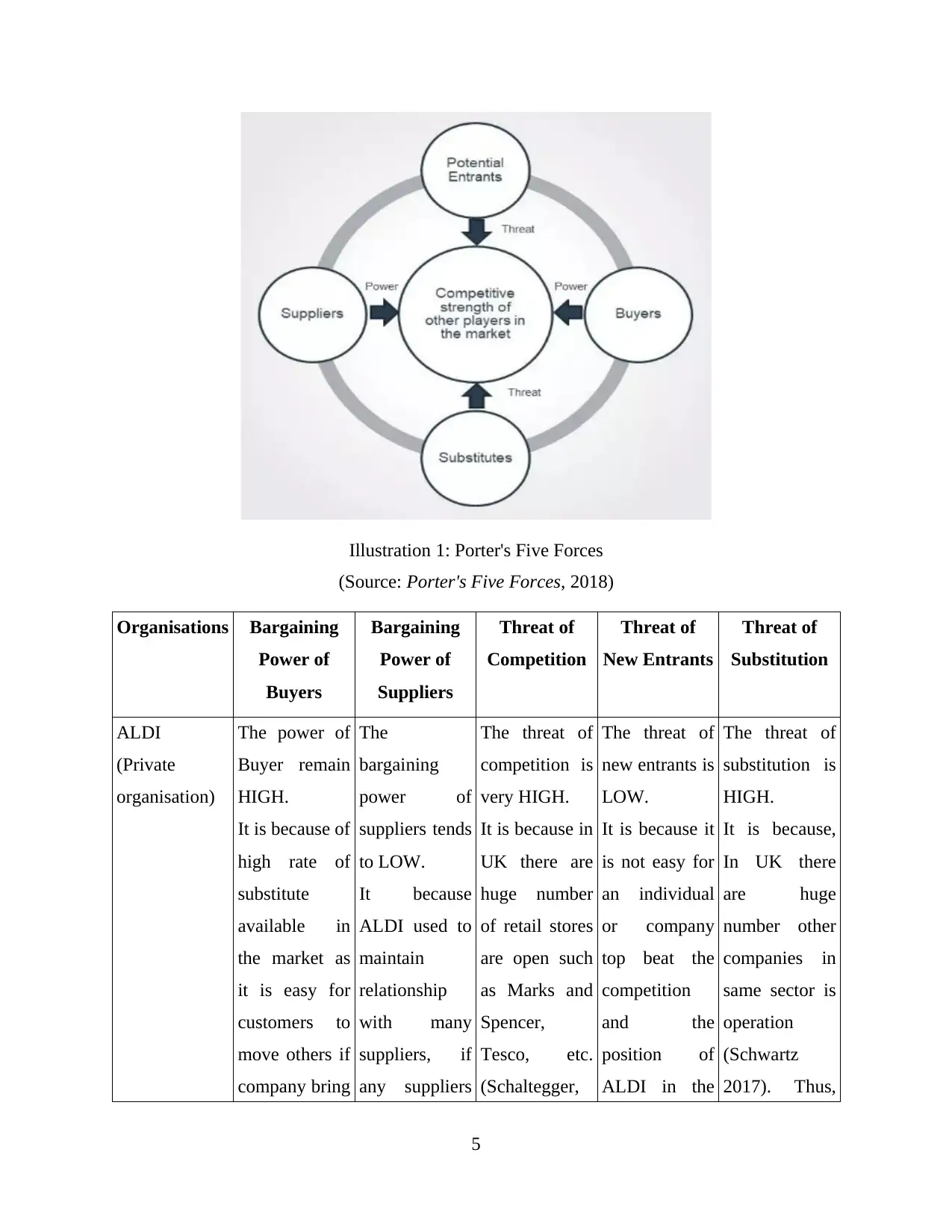
Illustration 1: Porter's Five Forces
(Source: Porter's Five Forces, 2018)
Organisations Bargaining
Power of
Buyers
Bargaining
Power of
Suppliers
Threat of
Competition
Threat of
New Entrants
Threat of
Substitution
ALDI
(Private
organisation)
The power of
Buyer remain
HIGH.
It is because of
high rate of
substitute
available in
the market as
it is easy for
customers to
move others if
company bring
The
bargaining
power of
suppliers tends
to LOW.
It because
ALDI used to
maintain
relationship
with many
suppliers, if
any suppliers
The threat of
competition is
very HIGH.
It is because in
UK there are
huge number
of retail stores
are open such
as Marks and
Spencer,
Tesco, etc.
(Schaltegger,
The threat of
new entrants is
LOW.
It is because it
is not easy for
an individual
or company
top beat the
competition
and the
position of
ALDI in the
The threat of
substitution is
HIGH.
It is because,
In UK there
are huge
number other
companies in
same sector is
operation
(Schwartz
2017). Thus,
5
(Source: Porter's Five Forces, 2018)
Organisations Bargaining
Power of
Buyers
Bargaining
Power of
Suppliers
Threat of
Competition
Threat of
New Entrants
Threat of
Substitution
ALDI
(Private
organisation)
The power of
Buyer remain
HIGH.
It is because of
high rate of
substitute
available in
the market as
it is easy for
customers to
move others if
company bring
The
bargaining
power of
suppliers tends
to LOW.
It because
ALDI used to
maintain
relationship
with many
suppliers, if
any suppliers
The threat of
competition is
very HIGH.
It is because in
UK there are
huge number
of retail stores
are open such
as Marks and
Spencer,
Tesco, etc.
(Schaltegger,
The threat of
new entrants is
LOW.
It is because it
is not easy for
an individual
or company
top beat the
competition
and the
position of
ALDI in the
The threat of
substitution is
HIGH.
It is because,
In UK there
are huge
number other
companies in
same sector is
operation
(Schwartz
2017). Thus,
5
Paraphrase This Document
Need a fresh take? Get an instant paraphrase of this document with our AI Paraphraser
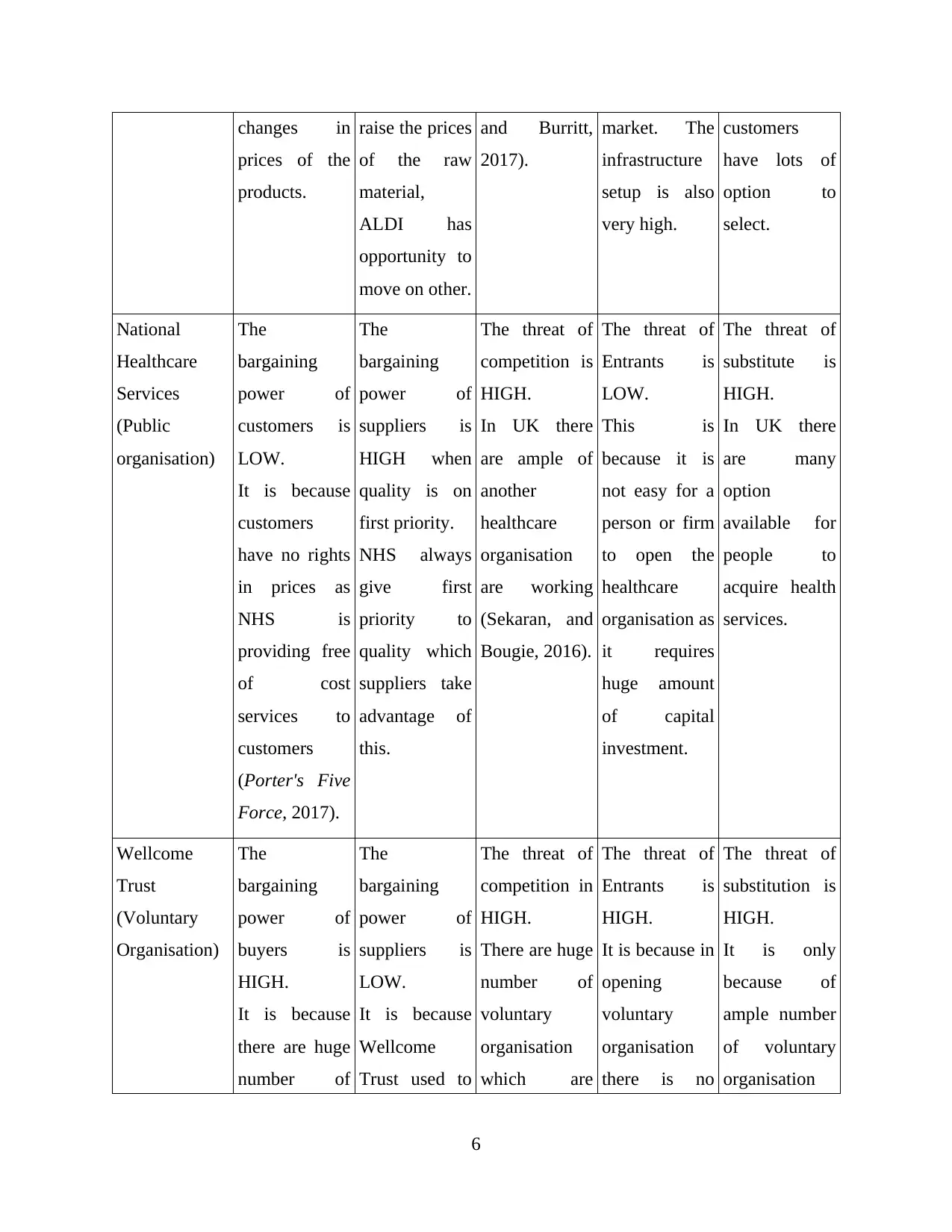
changes in
prices of the
products.
raise the prices
of the raw
material,
ALDI has
opportunity to
move on other.
and Burritt,
2017).
market. The
infrastructure
setup is also
very high.
customers
have lots of
option to
select.
National
Healthcare
Services
(Public
organisation)
The
bargaining
power of
customers is
LOW.
It is because
customers
have no rights
in prices as
NHS is
providing free
of cost
services to
customers
(Porter's Five
Force, 2017).
The
bargaining
power of
suppliers is
HIGH when
quality is on
first priority.
NHS always
give first
priority to
quality which
suppliers take
advantage of
this.
The threat of
competition is
HIGH.
In UK there
are ample of
another
healthcare
organisation
are working
(Sekaran, and
Bougie, 2016).
The threat of
Entrants is
LOW.
This is
because it is
not easy for a
person or firm
to open the
healthcare
organisation as
it requires
huge amount
of capital
investment.
The threat of
substitute is
HIGH.
In UK there
are many
option
available for
people to
acquire health
services.
Wellcome
Trust
(Voluntary
Organisation)
The
bargaining
power of
buyers is
HIGH.
It is because
there are huge
number of
The
bargaining
power of
suppliers is
LOW.
It is because
Wellcome
Trust used to
The threat of
competition in
HIGH.
There are huge
number of
voluntary
organisation
which are
The threat of
Entrants is
HIGH.
It is because in
opening
voluntary
organisation
there is no
The threat of
substitution is
HIGH.
It is only
because of
ample number
of voluntary
organisation
6
prices of the
products.
raise the prices
of the raw
material,
ALDI has
opportunity to
move on other.
and Burritt,
2017).
market. The
infrastructure
setup is also
very high.
customers
have lots of
option to
select.
National
Healthcare
Services
(Public
organisation)
The
bargaining
power of
customers is
LOW.
It is because
customers
have no rights
in prices as
NHS is
providing free
of cost
services to
customers
(Porter's Five
Force, 2017).
The
bargaining
power of
suppliers is
HIGH when
quality is on
first priority.
NHS always
give first
priority to
quality which
suppliers take
advantage of
this.
The threat of
competition is
HIGH.
In UK there
are ample of
another
healthcare
organisation
are working
(Sekaran, and
Bougie, 2016).
The threat of
Entrants is
LOW.
This is
because it is
not easy for a
person or firm
to open the
healthcare
organisation as
it requires
huge amount
of capital
investment.
The threat of
substitute is
HIGH.
In UK there
are many
option
available for
people to
acquire health
services.
Wellcome
Trust
(Voluntary
Organisation)
The
bargaining
power of
buyers is
HIGH.
It is because
there are huge
number of
The
bargaining
power of
suppliers is
LOW.
It is because
Wellcome
Trust used to
The threat of
competition in
HIGH.
There are huge
number of
voluntary
organisation
which are
The threat of
Entrants is
HIGH.
It is because in
opening
voluntary
organisation
there is no
The threat of
substitution is
HIGH.
It is only
because of
ample number
of voluntary
organisation
6
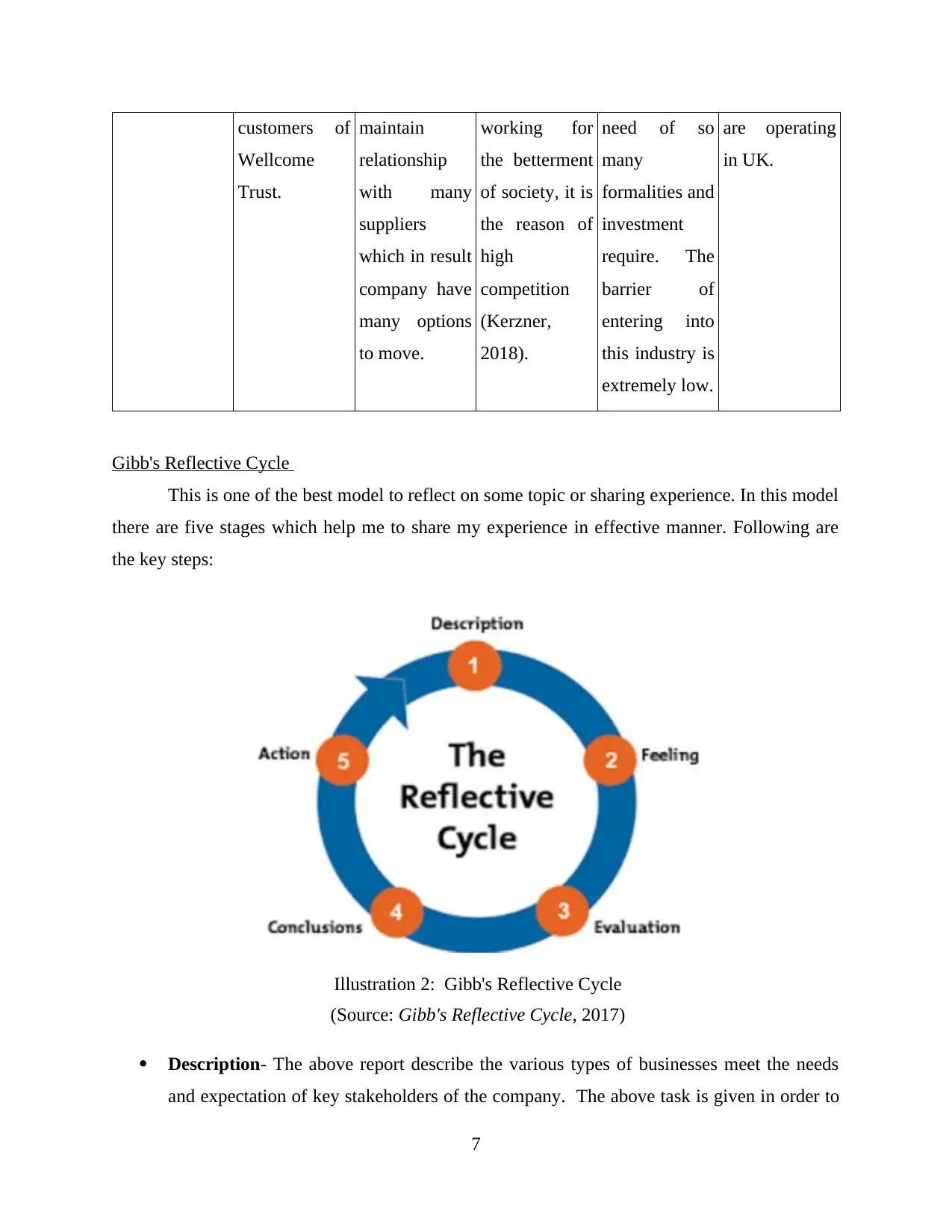
customers of
Wellcome
Trust.
maintain
relationship
with many
suppliers
which in result
company have
many options
to move.
working for
the betterment
of society, it is
the reason of
high
competition
(Kerzner,
2018).
need of so
many
formalities and
investment
require. The
barrier of
entering into
this industry is
extremely low.
are operating
in UK.
Gibb's Reflective Cycle
This is one of the best model to reflect on some topic or sharing experience. In this model
there are five stages which help me to share my experience in effective manner. Following are
the key steps:
Illustration 2: Gibb's Reflective Cycle
(Source: Gibb's Reflective Cycle, 2017)
Description- The above report describe the various types of businesses meet the needs
and expectation of key stakeholders of the company. The above task is given in order to
7
Wellcome
Trust.
maintain
relationship
with many
suppliers
which in result
company have
many options
to move.
working for
the betterment
of society, it is
the reason of
high
competition
(Kerzner,
2018).
need of so
many
formalities and
investment
require. The
barrier of
entering into
this industry is
extremely low.
are operating
in UK.
Gibb's Reflective Cycle
This is one of the best model to reflect on some topic or sharing experience. In this model
there are five stages which help me to share my experience in effective manner. Following are
the key steps:
Illustration 2: Gibb's Reflective Cycle
(Source: Gibb's Reflective Cycle, 2017)
Description- The above report describe the various types of businesses meet the needs
and expectation of key stakeholders of the company. The above task is given in order to
7
⊘ This is a preview!⊘
Do you want full access?
Subscribe today to unlock all pages.

Trusted by 1+ million students worldwide
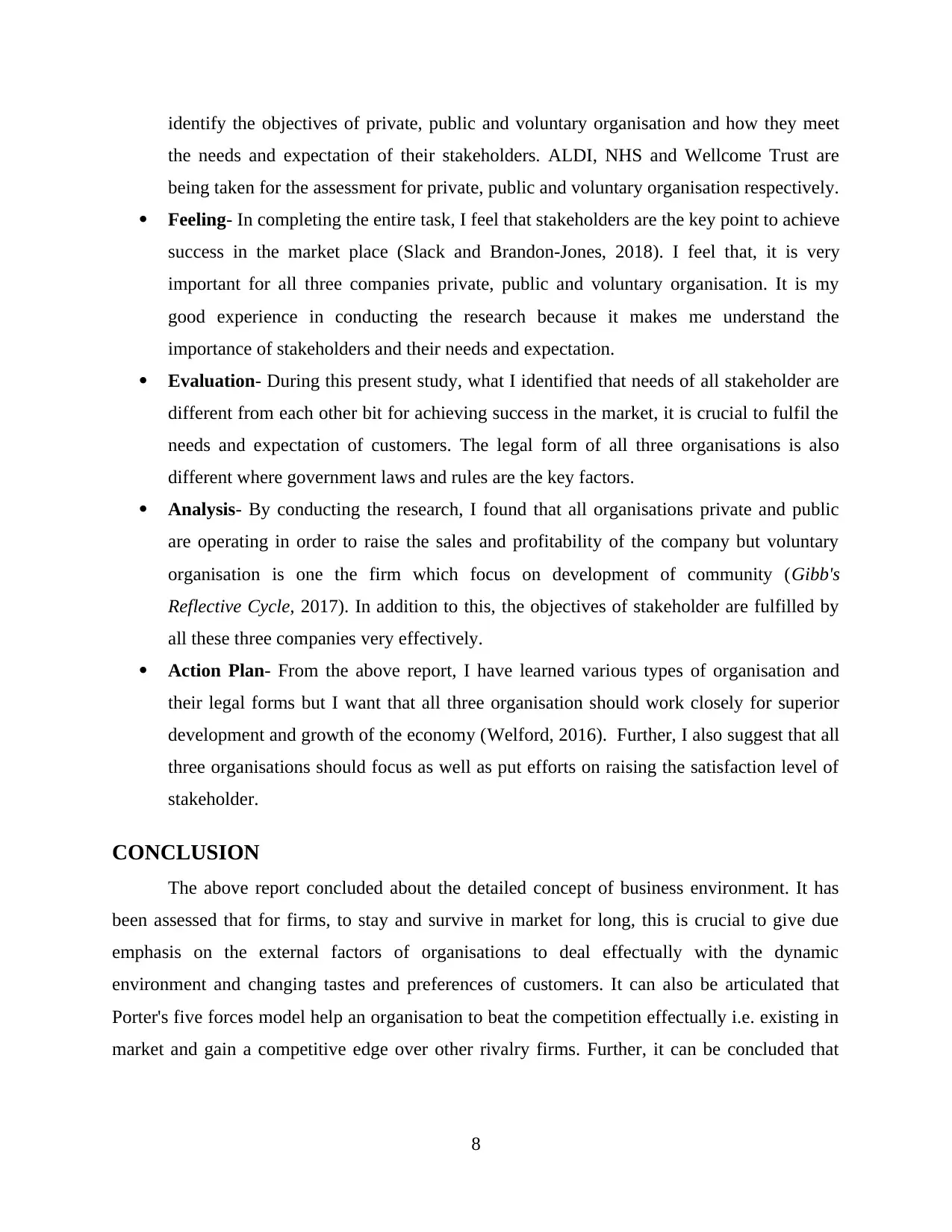
identify the objectives of private, public and voluntary organisation and how they meet
the needs and expectation of their stakeholders. ALDI, NHS and Wellcome Trust are
being taken for the assessment for private, public and voluntary organisation respectively.
Feeling- In completing the entire task, I feel that stakeholders are the key point to achieve
success in the market place (Slack and Brandon-Jones, 2018). I feel that, it is very
important for all three companies private, public and voluntary organisation. It is my
good experience in conducting the research because it makes me understand the
importance of stakeholders and their needs and expectation.
Evaluation- During this present study, what I identified that needs of all stakeholder are
different from each other bit for achieving success in the market, it is crucial to fulfil the
needs and expectation of customers. The legal form of all three organisations is also
different where government laws and rules are the key factors.
Analysis- By conducting the research, I found that all organisations private and public
are operating in order to raise the sales and profitability of the company but voluntary
organisation is one the firm which focus on development of community (Gibb's
Reflective Cycle, 2017). In addition to this, the objectives of stakeholder are fulfilled by
all these three companies very effectively.
Action Plan- From the above report, I have learned various types of organisation and
their legal forms but I want that all three organisation should work closely for superior
development and growth of the economy (Welford, 2016). Further, I also suggest that all
three organisations should focus as well as put efforts on raising the satisfaction level of
stakeholder.
CONCLUSION
The above report concluded about the detailed concept of business environment. It has
been assessed that for firms, to stay and survive in market for long, this is crucial to give due
emphasis on the external factors of organisations to deal effectually with the dynamic
environment and changing tastes and preferences of customers. It can also be articulated that
Porter's five forces model help an organisation to beat the competition effectually i.e. existing in
market and gain a competitive edge over other rivalry firms. Further, it can be concluded that
8
the needs and expectation of their stakeholders. ALDI, NHS and Wellcome Trust are
being taken for the assessment for private, public and voluntary organisation respectively.
Feeling- In completing the entire task, I feel that stakeholders are the key point to achieve
success in the market place (Slack and Brandon-Jones, 2018). I feel that, it is very
important for all three companies private, public and voluntary organisation. It is my
good experience in conducting the research because it makes me understand the
importance of stakeholders and their needs and expectation.
Evaluation- During this present study, what I identified that needs of all stakeholder are
different from each other bit for achieving success in the market, it is crucial to fulfil the
needs and expectation of customers. The legal form of all three organisations is also
different where government laws and rules are the key factors.
Analysis- By conducting the research, I found that all organisations private and public
are operating in order to raise the sales and profitability of the company but voluntary
organisation is one the firm which focus on development of community (Gibb's
Reflective Cycle, 2017). In addition to this, the objectives of stakeholder are fulfilled by
all these three companies very effectively.
Action Plan- From the above report, I have learned various types of organisation and
their legal forms but I want that all three organisation should work closely for superior
development and growth of the economy (Welford, 2016). Further, I also suggest that all
three organisations should focus as well as put efforts on raising the satisfaction level of
stakeholder.
CONCLUSION
The above report concluded about the detailed concept of business environment. It has
been assessed that for firms, to stay and survive in market for long, this is crucial to give due
emphasis on the external factors of organisations to deal effectually with the dynamic
environment and changing tastes and preferences of customers. It can also be articulated that
Porter's five forces model help an organisation to beat the competition effectually i.e. existing in
market and gain a competitive edge over other rivalry firms. Further, it can be concluded that
8
Paraphrase This Document
Need a fresh take? Get an instant paraphrase of this document with our AI Paraphraser
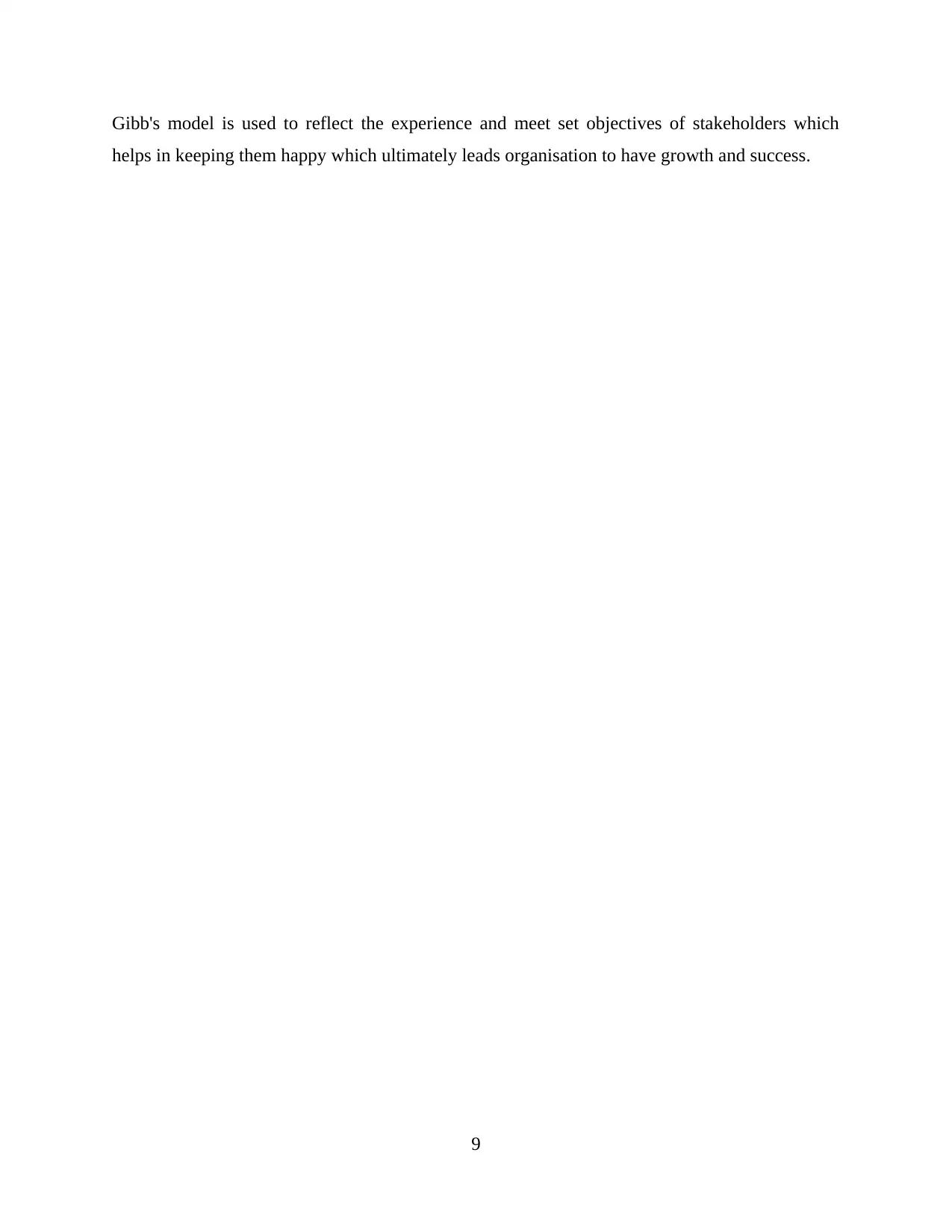
Gibb's model is used to reflect the experience and meet set objectives of stakeholders which
helps in keeping them happy which ultimately leads organisation to have growth and success.
9
helps in keeping them happy which ultimately leads organisation to have growth and success.
9
1 out of 11
Related Documents
Your All-in-One AI-Powered Toolkit for Academic Success.
+13062052269
info@desklib.com
Available 24*7 on WhatsApp / Email
![[object Object]](/_next/static/media/star-bottom.7253800d.svg)
Unlock your academic potential
Copyright © 2020–2025 A2Z Services. All Rights Reserved. Developed and managed by ZUCOL.





